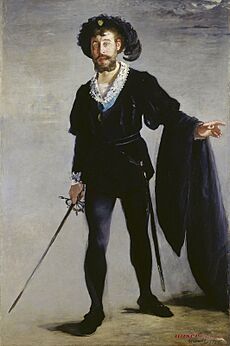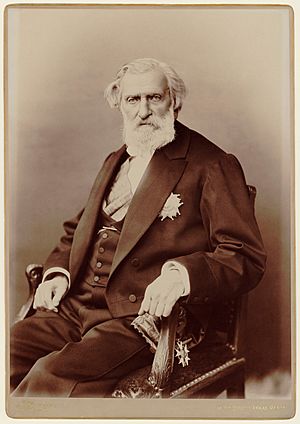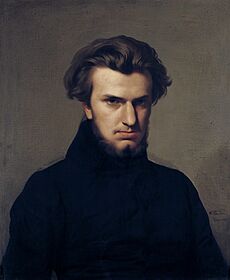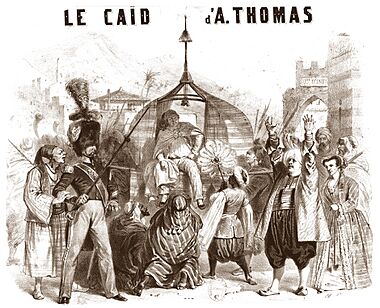Ambroise Thomas facts for kids
Charles Louis Ambroise Thomas (born August 5, 1811 – died February 12, 1896) was a French composer and teacher. He is best known for his famous operas, Mignon (from 1866) and Hamlet (from 1868).
Thomas grew up in a musical family. He studied at the Conservatoire de Paris, a top music school in France. There, he won the Prix de Rome, which is France's highest music award. He became a composer of operas, finishing his first one, La double échelle, in 1837. Over the next few decades, he wrote twenty more operas. Most of these were comedies, but he also wrote about more serious topics. His music was very popular with audiences in France and other countries.
In 1856, Thomas became a professor at the Conservatoire. Then, in 1871, he took over from Daniel Auber as the director. For the next 25 years, until his death in Paris, he updated how the Conservatoire was run. However, he also made the teaching very strict and old-fashioned. He didn't like modern music and tried to stop composers like César Franck and Gabriel Fauré from influencing the students.
For most of the 1900s, people didn't perform Thomas's operas much. But in recent years, his works have become popular again in Europe and the United States.
Contents
Life and Career
Early Years and Education
Ambroise Thomas was born in Metz. He was the youngest of four children. His parents, Martin and Jeanne Thomas, were both music teachers. By the age of ten, Ambroise was already very good at playing the piano and violin.
When he was twelve, his father passed away. His older brother, Charles, moved to Paris and played the cello in the Paris Opéra orchestra. In 1828, at 17, Ambroise joined his brother in Paris. He was accepted as a student at the Conservatoire de Paris. He learned piano from Pierre-Joseph-Guillaume Zimmerman and studied harmony and counterpoint (how different musical lines fit together) with Victor Dourlen. He won top prizes in these subjects in 1829 and 1830. He continued his studies, learning piano from Friedrich Kalkbrenner and composition from Jean-François Le Sueur and Auguste Barbereau.
In 1832, after his second try, Thomas won the Grand Prix de Rome. This was France's most important music prize. Winning it meant he could study for three years at the Villa Medici in Rome, which was home to the French Academy in Rome. While in Rome, he became friends with the painter Jean-Auguste-Dominique Ingres, who was the head of the academy. They both loved the music of Mozart and Beethoven. Thomas also met the famous composer Hector Berlioz, who encouraged him.
During his time in Italy, Thomas wrote chamber music. This included a piano trio, a string quintet, and a string quartet. He also wrote a collection of six songs called Souvenirs d'Italie. After leaving Rome, Thomas briefly visited Germany. He then returned to Paris in 1835 and started writing music for the stage.
Becoming a Composer
Thomas's first opera was La double échelle (The Double Ladder, 1837). It was a one-act comedy. The composer Berlioz praised it for being "extremely lively and witty." This opera was performed 247 times at the Opéra-Comique in Paris. In the next few years, it was also performed in Brussels, New Orleans, Berlin, Vienna, and London.
His first full-length opera was Le perruquier de la Régence (The Regency Wigmaker, 1838). Over the next ten years, he wrote six more operas, but none of them became very famous. During this time, he also composed a ballet called La Gipsy (1839).
His first truly successful three-act opera was Le caïd (The Qaid, 1849). A music expert, Elizabeth Forbes, described it as a mix of Il barbiere di Siviglia and L'italiana in Algeri. This opera stayed popular in France throughout the 1800s. It was performed over four hundred times in fifty years.
Thomas's next work for the Opéra-Comique was Le songe d'une nuit d'été (The Summer Night's Dream, 1850). This was also a big hit. The story was by Joseph-Bernard Rosier and Adolphe de Leuven. It was not based on A Midsummer Night's Dream by Shakespeare. Instead, Shakespeare himself appeared as a character, along with Queen Elizabeth I and Shakespeare's character Sir John Falstaff. The opera was first performed in Paris and then in many theaters across Europe and America. The Musical Times called it "a little masterpiece." It was often performed but became less popular after Thomas's death.
Later in 1850, Thomas's next opera, Raymond, premiered. It is not performed much today, but its overture (the opening music) became a popular piece for orchestras. In 1851, after the composer Gaspare Spontini died, Thomas was chosen to join the Académie des Beaux Arts.
Becoming a Professor
In 1856, Thomas became a professor of composition at the Conservatoire. Daniel Auber was the director at that time. Thomas stayed on the staff as a professor and later as director until he died forty years later. Some of his students became famous composers, like Jules Massenet, Gaston Serpette, and George Enescu. Other students became important music teachers, like Théodore Dubois and Charles Lenepveu. Conductors who studied with Thomas included Edouard Colonne and Désiré-Émile Inghelbrecht.

Thomas continued to compose during the 1850s, writing five operas. However, none of them were very successful. After a quiet period in the early 1860s, he wrote Mignon. This opera made his name widely known. The story (called a libretto) was written by Jules Barbier and Michel Carré. It was based on Goethe's novel Wilhelm Meisters Lehrjahre.
Elizabeth Forbes noted that Thomas had a very good and dramatic story for this opera. In the novel, Mignon dies, but the opera has a happy ending, which worked well. A happy ending was required at the Opéra-Comique back then. It was nine years later that Carmen broke this rule by ending with the main character's death. The first cast of Mignon was excellent. Célestine Galli-Marié, a famous singer, played the main role. She later also created the role of Carmen in Bizet's opera.
Thomas was also lucky with the cast for his next success, Hamlet (1868). Jean-Baptiste Faure played Hamlet, and Christine Nilsson played Ophelia. The opera was loosely based on Shakespeare's play. The story was adapted by Alexandre Dumas, père and Paul Meurice, and then turned into a libretto by Carré and Barbier. Even though some critics felt the opera changed the play too much (it included a ballet, which was required in grand operas, and a happy ending where Hamlet becomes king), it was successful in Paris and London. Despite some negative reviews of the story from English-speaking critics, the opera is still performed sometimes. Famous singers who played Ophelia included Emma Calvé and Nellie Melba. Hamlets included Titta Ruffo and Thomas Hampson.
Even though Thomas was known for being traditional in his music, the score of Hamlet was new in one way: it used saxophones in the orchestra. Later in Thomas's life, his work as a teacher and director became more important than his composing. After Hamlet, he wrote only one more opera: Françoise de Rimini (1882). It was well-received but didn't become a regular part of the opera repertoire.
Later Years and Directorship
When the Franco-Prussian War started in 1870, Thomas was almost sixty. Still, he volunteered to serve in the Garde Nationale. The next year, Auber resigned as director of the Conservatoire and soon died. Thomas was then chosen to be the new director. Everyone expected him to get the job. The minister of education, Jules Simon, even wrote to Thomas saying, "You are so clearly suited for the job that if I didn't choose you, it would be like firing you from a position that's already yours."
As director, Thomas ran a very traditional school. He believed that the music of Auber, Fromental Halévy, and especially Giacomo Meyerbeer was the right example for students. He strictly kept older French music, like that of Jean-Philippe Rameau, and modern music, including Wagner, out of the curriculum. Thomas tried to stop modern musicians from teaching at the Conservatoire. He failed with César Franck, who was hired against Thomas's wishes in 1872. But he succeeded in delaying Gabriel Fauré's appointment until after Thomas's death.
However, Thomas also made some good changes at the Conservatoire. He added more classes, improved working conditions for the teachers, and expanded the curriculum. He added solfège (singing musical notes), sight-reading, and required orchestral practice. Teachers under Thomas included composers like Franck, Théodore Dubois, and Jules Massenet, and singers like Pauline Viardot.
In 1889, the Opéra staged Thomas's ballet La tempête (another work based on a Shakespeare play – The Tempest). But it didn't make a big impression. In 1894, after the 1,000th performance of Mignon at the Opéra-Comique, the elderly Thomas was hugged on stage by Giuseppe Verdi, who was two years younger. Then, President Carnot gave Thomas the highest French honor, the Grand-Croix de la Légion d'honneur.
Thomas died in his apartment at the Conservatoire in 1896, at the age of 84. He died from lung problems. His wife, Elvire, whom he married in 1878, survived him. Dubois took over as director of the Conservatoire after Thomas.
Music
The composer Emmanuel Chabrier once joked, "There is good music, there is bad music, and then there is Ambroise Thomas." It's not clear exactly what Chabrier meant, but it shows that Thomas's music was seen differently by people.
In the first edition of Grove's Dictionary of Music and Musicians (1889), Gustave Chouquet wrote about Thomas. He said Thomas had a natural talent for the stage and was great at showing different emotions in his music. He also praised Thomas's skill with the orchestra, saying he could create new sounds without making the music too loud for the singers. Chouquet felt that if Thomas had been a bit more daring with his melodies, he would be among the top modern composers. Still, he called Thomas a "first-rate dramatic composer" because of his pure and varied style.
In a later edition of Grove, music expert Richard Langham Smith wrote that Thomas was very important in French opera of the late 1800s. He called him an "imaginative innovator" and a "master of musical characterization." Langham Smith concluded that after many years of being forgotten, Thomas's work saw a big comeback starting in the late 1900s. There were major performances of Mignon and Hamlet in France, Britain, and the US.
Elizabeth Forbes wrote that Thomas was a composer who could write in many different styles. She said that Ferdinand Hérold and Auber influenced his early works. She believed Le caïd was his first truly original work, even though it still showed the influence of Gioachino Rossini. In later works, Thomas's music could sometimes still copy others. Forbes mentioned Psyché (1857) as a weaker copy of Gounod's Sapho. She also said his Le carnaval de Venise (also 1857) copied Victor Massé.
Forbes concluded that at his best, Thomas wrote lovely and unique music. His orchestration (how he used the instruments) was "often quite ravishing." He also musically showed the characters of important roles very clearly. She believed that if Thomas had only written Mignon and Hamlet, he would probably be more widely known as one of the most important French opera composers of the 1800s.
List of Compositions
Operas
See: List of operas by Ambroise Thomas.
Ballets
- La gipsy (1839)
- Betty (1846)
- La tempête (1889)
Images for kids
See also
 In Spanish: Ambroise Thomas para niños
In Spanish: Ambroise Thomas para niños





